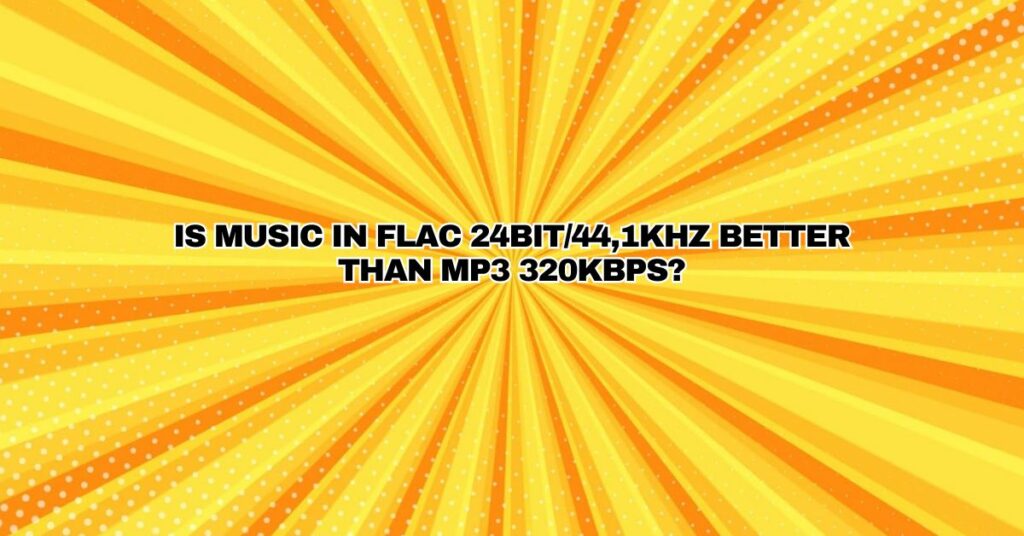In the world of digital audio, the choice of format can significantly impact your listening experience. Two common formats that listeners encounter are FLAC (Free Lossless Audio Codec) at 24-bit/44.1 kHz and MP3 at 320 kbps (kilobits per second). This comprehensive guide will compare the two formats in terms of audio quality, compression, and practicality to help you determine which is better suited to your needs.
Understanding FLAC 24-bit/44.1 kHz and MP3 320 kbps
- FLAC 24-bit/44.1 kHz:
- FLAC is a lossless audio format, which means it doesn’t discard any audio data during compression.
- 24-bit refers to the bit depth, which allows for a wide dynamic range and high precision.
- 44.1 kHz is the sample rate, representing 44,100 audio samples captured per second.
- MP3 320 kbps:
- MP3 is a lossy audio format, which means it employs data compression to reduce file size.
- 320 kbps represents the bit rate, indicating the amount of data transmitted per second. Higher bit rates generally result in higher audio quality.
Comparing Audio Quality
Let’s break down the comparison between these two formats in terms of audio quality:
FLAC 24-bit/44.1 kHz:
- FLAC is a lossless format, which means it retains all the original audio data from the source.
- 24-bit bit depth provides an extensive dynamic range, capturing subtle audio details, particularly in the quiet and loud portions of the audio.
- 44.1 kHz sample rate is CD quality and can accurately represent the entire range of human hearing, from deep bass to high treble.
MP3 320 kbps:
- MP3 is a lossy format, which means it sacrifices some audio data to reduce file size.
- 320 kbps bit rate is relatively high for MP3, indicating less compression and higher audio quality compared to lower bit rates.
- It still provides good audio quality, especially for casual listening, but it may discard some subtle details, particularly in complex or intricate musical passages.
Audio Quality Comparison:
- FLAC 24-bit/44.1 kHz:
- Offers the highest audio quality and is considered a reference standard for lossless audio.
- Ideal for audiophiles, studio recordings, critical listening, and archival purposes.
- Captures the full range of audio nuances, making it suitable for high-end audio systems.
- MP3 320 kbps:
- Offers very good audio quality for most listening scenarios, especially on portable devices and during casual listening.
- Strikes a balance between quality and file size, providing practicality for streaming and storage.
- May not capture the most minute audio details but is suitable for the average listener.
Practical Considerations
When deciding between these formats, consider practical factors:
- Storage Space: FLAC files are larger, requiring more storage space. MP3 files, being compressed, take up less space.
- Playback Devices: Some devices may not support FLAC or may require third-party apps for playback, while MP3 is universally supported.
- Listening Environment: In a high-fidelity sound system, the difference between the two formats may be more noticeable than on portable devices or in a noisy environment.
- Listening Preferences: Audiophiles and those who demand the highest audio quality may prefer FLAC, while the average listener may not discern a significant difference.
Conclusion:
The choice between FLAC 24-bit/44.1 kHz and MP3 320 kbps depends on your listening preferences and practical needs. FLAC offers the pinnacle of audio quality, making it ideal for audiophiles and studio use. However, MP3 320 kbps provides very good audio quality while offering the advantage of smaller file sizes and universal compatibility. For critical listening and high-end systems, FLAC is the superior choice, while MP3 remains a highly practical and satisfactory format for most listeners. Your choice should align with your specific listening habits and equipment.

